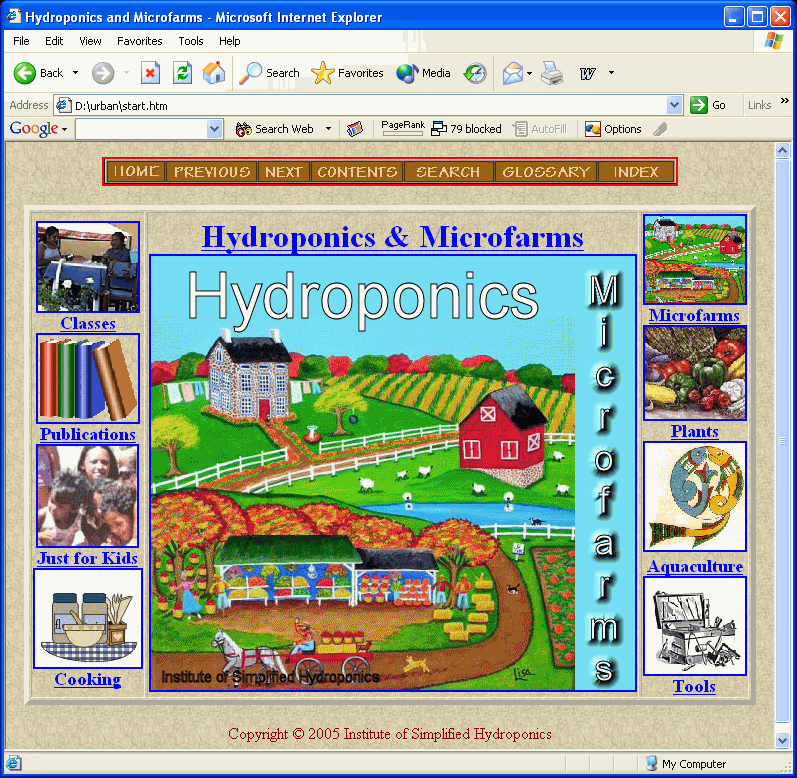Hydroponics and Microfarms CDROM

The Institute for Simplified Hydroponics has the mission of ending hunger with hydroponic technology. To support these
efforts worldwide the Institute has created a CDROM containing over 800 pages of information on hydroponics and microfarming.
Contents:
Troubleshooting
1. Insects A comprehensive encyclopedia of insects including methods of prevention and organic methods of control.
2. Diseases A comprehensive encyclopedia of plant diseases including methods of prevention and organic methods of control.
3. Nutrients for plants A comprehensive encyclopedia of nutritional signs in plants including what the causes could be and how to prevent or control.
Hydroponic education
1. Comic Book A comic book for children from 7 to 10 which explains how to build a hydroponic garden from objects found in the neighborhood.
2. Coloring Book A coloring book for children 6 to 9 that shows homeless children building their own simplified hydroponic garden.
3. Science Experiments Book A 84 page book for students 10 to 14 to help with science projects in hydroponics. Includes designs and experiments.
4. Elementary Class A 15 unit curriculum including lectures and experiments for learning about hydroponics elementary school level.
5. Middle School Class A 16 unit curriculum including lectures and experiments for hydroponic design middle school level.
6. Growing Plants model A computer model that simulates the building and growing of plants.
7. Aquaculture Model Extensive science based computer model of aquaculture.
8. Mars Station A sample design project of a Mars based human shelter using hydroponics for food, oxygen generation and waste air and water cleaning.
Simplified Hydroponics
1. Home Hydroponic Gardens An electronic copy of 240 page book Home Hydroponic Gardens by Peggy Bradley and Cesar Marulanda.
2. Several articles on projects throughout the world using simplified hydroponics to end hunger and poverty.
3. Training for Microgardens A 15 unit training manual for training a person who cannot read or write in the technology of simplified hydroponics.
Advanced commercial hydroponics
1. Greenhouse Manual A 64 page book on greenhouse operation including extensive techical data on lighting, heat loading and cooling.
2. Hydroponic Nutrient calculations A Excel spreadsheet to calculate the ppm values of hydroponic nutrients. Includes pages of information on all available ferilizers and how to be used in hydroponic culture.
3. Conversions An Excel speadsheet of conversions from engish to metric systems, and over 1000 other useful conversions for engineers.
4. Commercial Designs Six detailed designs on commercil hydroponic projects from a 16 by 24 foot greenhouse for a home, a biosphere home, and three commercial hydroponic greenhouse operations. Information includes recipes for commercial nutrients.
5. Growing substrates A comprehensive list of growing media with extensive technical data.
6. Greenhouse Heat A spreadsheet to help calculate BTU heat losses and gains from any greenhouse design.
7. Plant Growing Information A encyclopedia of plant information on how to grow over 100 plants in hydroponic culture. Includes vegetables, herbs and medicial plants.
8. Garden Calculations A spreadsheet to calculate the necessary tubs or surface space to produce a wide variety of vegetables. information includes nutritional values of the produced foods.
Microfarms
1. Microfarm - A sample microfarm example designed for Mexico that shows a single hectare (2.4 acres of land) that provides a family income of $50,000 a year in Mexico.
2. Tibet Microfarm A scientific paper of using microfarm technology to support yak nomads of Tibet.(PDF file for Adobe Acrobat)
3. Design ToolsSupporting technical information on the following microfarm topics.
a. Solarcooking - instructions on how to build and operate a solar stove. Full plans included.
b. Composting toilets - technical information and detailed instructions on how to build and operate a composting toilet.
c. Solar power - instructions on how to set up and operate a 12 volt solar powered system using solar cells.
d. Wind power - instructions on how to set up and operate a wind power system.
e. Aquaculture - a full unit of over 100 pages of information including computer models on setting up and operating an aquaculture pond and connecting the fish water with hydroponic culture.
f. Fertigation - using hydroponic nutrient water in drip irrigated soil based systems to use for field crops and larger scale production. Includes information on using fertigation for corn and legumes in rotation to reduce nitrogen costs.
g. Berry culture - in hydroponics and fertigation - technology of using several types of berries including blackberries for a barrier fence.
h. Flowers Flower culture in hydroponics using human wastewater or organic nutrients. Flower fields are established to eliminate the waste water from a family.
i. rainwater gathering - systems and technical information on setting up a rainwater gathering system to provide fresh clean drinking water for the family. Unit includes information on fog water gathering for high mountain areas.
j. Goat and small livestock - using the wastes for hydroponic culture.
k. Worm farm - operating a worm farm to generate a hydroponic nutrient for organoponics. Extensive information on Cuba's methods or organoponics.
l. Recipe List Over 600 recipes for international foods.
The entire CD is designed as a large website. It can be loaded onto your computer using your web broswer such as Microsoft Internet Explorer. The links make searching the CDROM very easy. Each plant is hot linked to the possible diseases and insects that might attack it. This CD will be used to support efforts worldwide to use hydroponics and microfarming to people in need. That is one out of six of the people on the earth.
Find the CDROM at your nearest hydroponi store or purchase online at the Institute website www.carbon.org.
Cost: $19.95 Buy online or At your nearest hydroponic store
Revised:
1 January 2008
Copyright
© 2008 Institute for Simplified Hydroponics
|

